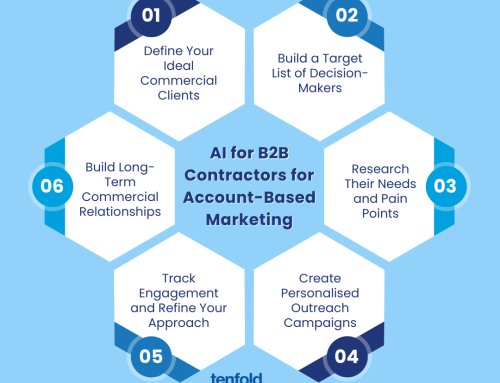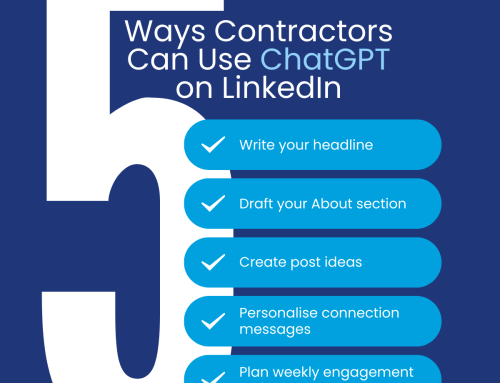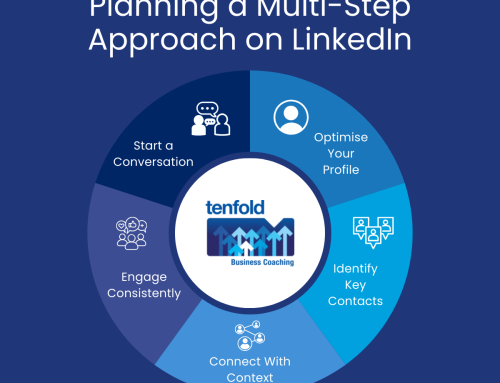Account-Based Marketing (ABM) for Contractors: Connect with Facilities & Property Managers [Template, Examples, Checklist]
If you’re a contractor working in sectors like education, healthcare, industrial, retail or government, you already know that winning the right kind of work isn’t just about quoting sharply or showing up on time. It’s about building strong commercial relationships with the decision-makers who manage the properties, facilities, and projects you want to work on. That’s where Account-Based Marketing (ABM) comes in. ABM flips the traditional marketing funnel on its head. Instead of casting a wide net and trying to reach as many potential clients as possible, you focus your efforts on a select group of high-value targets (facilities managers, property managers, strata managers, and Tier 2–3 builders) who are most likely to benefit from your services. These targets are also the ones most likely to become long-term, loyal clients who can significantly contribute to the growth of your business.
I’m Ashley Thomson, a business coach with over 20 years of experience helping contractors grow sustainably and profitably. At Tenfold Business Coaching, I’ve worked with hundreds of small businesses to develop practical strategies that deliver bankable results. My background in engineering and corporate consulting means I understand how complex organisations operate and how to position your business to win work with them. I’ve also bought, run and sold my own business, so I know what it takes to build something that lasts.
What Is Account-Based Marketing (ABM) and Why It Works for Contractors
ABM is a targeted marketing approach that treats each potential client as a market of one. Instead of relying on generic campaigns, you tailor your outreach to the specific needs, challenges, and goals of the businesses or managers you want to work with. For contractors, this means identifying the key players in your target sectors and creating personalised strategies to engage them. This approach allows for a more precise and effective marketing effort, ensuring that your message resonates directly with the individuals who matter most.
This approach works especially well in industries like education, healthcare and government because these sectors are relationship-driven. Facilities Managers and Property Managers don’t just want a contractor who can do the job, they want someone who understands their operational pressures, compliance requirements and long-term asset plans. ABM helps you demonstrate that understanding from the first touchpoint.
Step 1: Define Your Ideal Commercial Clients
Start by identifying the types of clients who are most aligned with your services and growth goals. Think beyond just the sector; consider other factors as well. For instance, consider the size of their organisation, the scope of their facilities, and the types of work they typically outsource. For example, a Tier 2 builder working on modular classrooms for a government school rollout will have very different needs compared to a Strata Manager overseeing high-rise residential buildings.
Use your existing client base as a reference. Reflect on who your best clients are now and what makes them profitable and easy to work with. Build a profile around those traits and use it to guide your account-based marketing (ABM) targeting. Consider creating a detailed description of your ideal clients, including their industries, company sizes, decision-makers, and specific needs. This profile can help you focus your efforts more effectively and tailor your approach to attract more of these valuable clients.
Step 2: Build a Target List of Decision-Makers
Once you’ve defined your ideal client profile, begin building a list of actual businesses and decision-makers that fit this description. This could include Facilities Managers in public hospitals or aged care centres, Property Managers overseeing retail precincts or industrial parks, Strata Managers managing large residential complexes, and Tier 2 and Tier 3 builders working on education or government infrastructure. Additionally, consider reaching out to industry associations or attending relevant networking events to expand your reach and gain more insights into potential clients.
You can use LinkedIn, industry directories, tender portals, and your own network to identify names, roles, and contact details. Keep your list tight and focused. Account-Based Marketing (ABM) emphasises quality over quantity, so prioritise building a targeted and refined list of contacts.
Step 3: Research Their Needs and Pain Points
Before you reach out, do your homework. Look into the kind of projects they are involved in and the challenges they are likely facing. For instance, a Facilities Manager in a healthcare setting might be juggling reactive maintenance along with strict hygiene protocols. A Strata Manager might be dealing with rising insurance costs and the pressure from residents to improve energy efficiency.
The more you understand their world, the more relevant your messaging will be. This is where your business coaching mindset comes in. Think like a problem solver rather than a salesperson. By adopting this approach, you can better connect with your audience and meet their needs effectively.
Step 4: Create Personalised Outreach Campaigns
Now it’s time to engage. Your outreach should be tailored to each target and demonstrate that you’ve done your research. An effective Account-Based Marketing (ABM) campaign might begin with a personalised email introducing your business and referencing a specific challenge they face. You could follow up with a detailed case study showcasing how you’ve successfully solved similar problems for other clients. Including a short video or a brochure that directly addresses their sector can help reinforce your message. Finally, offer a follow-up call or a free site visit to establish a foundation for a more in-depth conversation.
Keep your tone professional but approachable. Remember, you’re not merely pitching a service; you’re proposing a strategic partnership, which requires building trust and demonstrating value. Approach each interaction as an opportunity to establish a collaborative relationship.
Step 5: Track Engagement and Refine Your Approach
ABM is not a one-and-done strategy. It requires ongoing effort and attention. Track who opens your emails, who clicks through to your website, and who responds. Use that data to refine your messaging and prioritize your follow-ups. If someone doesn’t respond, try a different angle. If someone shows interest, move quickly to build the relationship and deepen engagement.
This is the area where business coaching services can truly make a significant difference. A small business coach can assist you in analysing your results, adjusting your strategy as needed, and remaining accountable to your growth objectives. This guidance can be instrumental in helping your business reach new heights and achieve its full potential.
Step 6: Build Long-Term Commercial Relationships
ABM is not just about landing one job; it’s about becoming the go-to contractor for a portfolio of properties or projects. Once you’ve won the work, deliver it with excellence. Communicate clearly, meet deadlines, and always look for ways to add value. Then, stay in touch regularly. Share updates, offer insights, and keep the relationship warm by maintaining consistent contact.
Over time, these relationships become a valuable source of repeat business, referrals, and strategic growth. That is the true power of Account-Based Marketing (ABM) when it is supported by strong business coaching. Expanding these relationships helps create a solid foundation for ongoing success and collaboration.
Real-World Example: ABM in Action for a Tier 2 Builder
One of my clients, a commercial contractor specialising in modular builds, used ABM to connect with Tier 2 builders working on government school upgrades. Instead of sending out generic capability statements, they created tailored proposals for each builder, referencing specific project timelines and compliance requirements. They followed up with phone calls offering to assist with pre-construction planning. Within six months, they secured three new contracts and built relationships that led to ongoing work.
That’s the kind of result you can achieve when you combine strategic marketing with business coaching services that keep you focused and accountable.
Why Contractors Should Work with a Business Coach to Execute ABM
If you’re ready to stop chasing low-margin jobs and start building strategic relationships that fuel long-term growth, Account-Based Marketing is the way forward. It’s a proven approach that helps contractors like you connect with the right decision-makers in the right sectors, without wasting time or resources. As a business coach, I’ve seen firsthand how ABM transforms not just your pipeline, but your confidence and positioning in the market. If you want support to tailor your ABM strategy, refine your messaging or stay accountable to your goals, I’d be glad to help. Let’s make your next move a smart one.
FAQs About ABM for Contractors
What’s the difference between ABM and traditional marketing?
ABM targets specific high-value clients with personalised campaigns, while traditional marketing casts a wider net with generic messaging.
Do I need a big marketing budget to run ABM?
No. ABM is more about time and strategy than money. A small business coach can help you maximise impact with minimal spend.
How long does it take to see results from ABM?
It depends on your sector and outreach quality. Many contractors see early engagement within weeks and commercial wins within months.
Can ABM work for subcontractors or niche trades?
Absolutely. If you solve a specific problem for a specific type of client, ABM helps you position yourself as the expert they need.
How can business coaching help with ABM?
Business coaching services provide strategic guidance, accountability and insights to help you plan, execute and refine your ABM campaigns effectively.


![Account-Based Marketing (ABM) for Contractors: Connect with Facilities & Property Managers [Template, Examples, Checklist] | Tenfold Business Coaching](https://tenfoldcoaching.com.au/wp-content/uploads/2025/09/Account-Based-Marketing-ABM-for-Contractors-Connect-with-Facilities-Property-Managers-Template-Examples-Checklist.png)



